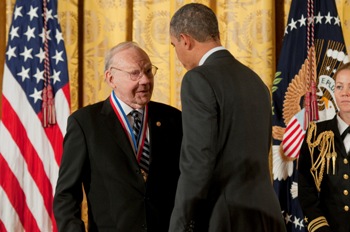Apr 5 2013
Cancer painfully ends more than 500,000 lives in the United States each year, according to the Centers for Disease Control and Prevention. The scientific crusade against cancer recently achieved a victory under the leadership of University of Missouri Curators' Professor M. Frederick Hawthorne.
 M. Frederick Hawthorne’s team developed a new form of radiation therapy that successfully put cancer into remission in mice. Hawthorne received the National Medal of Science from President Obama in the East Room of the White House on February 1, 2013. (Credit: Ryan K Morris/National Science & Technology Medals Foundation)
M. Frederick Hawthorne’s team developed a new form of radiation therapy that successfully put cancer into remission in mice. Hawthorne received the National Medal of Science from President Obama in the East Room of the White House on February 1, 2013. (Credit: Ryan K Morris/National Science & Technology Medals Foundation)
Hawthorne's team has developed a new form of radiation therapy that successfully put cancer into remission in mice. This innovative treatment produced none of the harmful side-effects of conventional chemo and radiation cancer therapies. Clinical trials in humans could begin soon after Hawthorne secures funding.
"Since the 1930s, scientists have sought success with a cancer treatment known as boron neutron capture therapy (BNCT)," said Hawthorne, a recent winner of the National Medal of Science awarded by President Obama in the White House. "Our team at MU's International Institute of Nano and Molecular Medicine finally found the way to make BNCT work by taking advantage of a cancer cell's biology with nanochemistry."
Cancer cells grow faster than normal cells and in the process absorb more materials than normal cells. Hawthorne's team took advantage of that fact by getting cancer cells to take in and store a boron chemical designed by Hawthorne. When those boron-infused cancer cells were exposed to neutrons, a subatomic particle, the boron atom shattered and selectively tore apart the cancer cells, sparing neighboring healthy cells.
The physical properties of boron made Hawthorne's technique possible. A particular form of boron will split when it captures a neutron and release lithium, helium and energy. Like pool balls careening around a billiards table, the helium and lithium atoms penetrate the cancer cell and destroy it from the inside without harming the surrounding tissues.
"A wide variety of cancers can be attacked with our BNCT technique," Hawthorne said. "The technique worked excellently in mice. We are ready to move on to trials in larger animals, then people. However, before we can start treating humans, we will need to build suitable equipment and facilities. When it is built, MU will have the first radiation therapy of this kind in the world."
Hawthorne believes that his discovery was possible only at the University of Missouri because MU has three features that separate it from other universities in the nation, the reason Hawthorne came to MU from the University of California, Los Angeles in 2006.
"First, it is an example of a small number of universities in the United States with a large number of science and engineering disciplines on the same campus," said Hawthorne. "Second, the largest university research nuclear reactor is located at MU. Finally, it has strong, collegial biomedicine departments. This combination is unique."